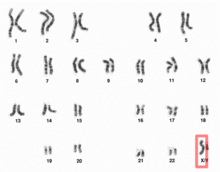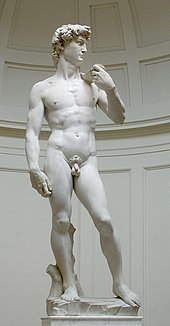man
Man refers to a male , adult person and refers to the biological gender or the gender role of a person or both (compare gender ). Male children and adolescents are referred to as boys . The polite form of address for a man is “Herr” in German , and accordingly a distinction is made in some sports between “women's and men's sports”.
The development of the biological sex is genetically determined by a pair of chromosomes XY , whereby the development of male primary and secondary sexual characteristics is mainly controlled by the Y chromosome and the male sex hormone testosterone . Men produce sperm that can be used to fertilize eggs . In contrast to women with typical genetic development, they are not able to become pregnant at any stage of their life.
In addition, there are trans men whose gender identity differs from the gender assigned to them at birth, as well as intersex people with gender characteristics that do not match the gender classification of “man” or “woman”. Due to the fundamental influences of gender on human society , the term man is loaded with many other interrelated and sometimes very emotional meanings (see also masculinity ). As a symbol of man's masculinity and the male sex which is generally mars symbol ♂ used.
etymology
That is common. Word mhd. , Ahd. One goes back to idg. Manu- or monu- "Mensch, Mann". It is not possible to clarify with certainty which conception this naming of man is based on.
Biological and medical characteristics
Genetic traits
From a molecular biological point of view, men and women are distinguished by the chromosome pair XY (see also XX men ) in the sex chromosomes (instead of XX in women, but see also XY women ). This difference leads to a gender dimorphism . When an X chromosome from the maternal side ( egg cell ) and a Y chromosome from the paternal side ( sperm ) come together in the zygote , the genital organs develop during embryonic development. Men usually have an X and the sex-determining Y chromosome in their chromosome set . The latter contains a region that one sex determining region of Y (SRY) called and the man for embryonic production of the determining testicular factor (TDF for English: testis-determining factor ), a protein , is responsible. If TDF is formed, male characteristics develop; if it is missing, however, female characteristics are formed.
Morphological and physiological characteristics

Men are physically different from women in terms of their primary and secondary sex characteristics . The structure of the primary sexual characteristics is mainly determined by the function in reproduction. These are mainly
- the presence of male gonads , the testicles in which the male gametes , the sperm , are produced.
- the development of the primary sexual characteristics penis and scrotum in the human embryo .
- the development of secondary gender characteristics during puberty , such as beard growth , a deeper voice than women, wider shoulders , a narrower pelvis , lower body fat and higher muscle percentage of the total weight, higher growth and generally stronger body hair, all of which are the result of a higher level in the male Sex hormone testosterone in the blood.
For information on missing gender characteristics and gender diversity, see intersexuality and transgender .
skeleton

Female and male pelvis are different. The femoral bone hole is oval in shape and the pelvic blades are wider. The male pelvis, on the other hand, is rather high, narrow and narrow. The most important feature to distinguish it is the angle of the pubic symphysis. It is greater than 90 ° in the female pelvis and less than 90 ° in the male.
The skull shapes also differ. Only men's skulls have a clearly pronounced bulge above the eyes.
The proportions of the fingers of men and women are different. For most men, the ring finger is longer than their index finger . In women, however, the index finger is longer than the ring finger or at least the same length. A common hypothesis sees the cause of the different finger length ratio in the testosterone level in the womb.
Men's skin
The appearance of male skin (oily and larger-pored than female skin) is mainly influenced by hormonal skin differences, e.g. B. by the thickness of the skin and the increased secretion of sebum.
The thicker male skin has a higher water-binding capacity, which makes the skin look tighter and firmer. The increased sebum production is responsible for a sufficient amount of moisture in the skin and for the composition of the so-called hydrolipid film. This film regulates the water content of the deeper layers, prevents dehydration and gives the skin a smooth, supple appearance.
In addition, men's skin has a lower tendency to wrinkle. Wrinkles usually appear later in men than in women and not as small creases, but more as deep (“distinctive”) wrinkles.
As a result of the increased sebum production, blackheads and acne can occur more often, especially in young men . These occur when the sebum attaches to the pores together with dead skin cells. Irritation of the blackheads leads to the colonization of germs and inflammatory pimples .
Andrology
The specialty of medicine that deals with male diseases is called andrology . In general, men can suffer from the same diseases as women, but some gender-specific diseases also exist ; For some other diseases, women and men show significantly different disease distributions (e.g. for red-green poor eyesight and other X-linked hereditary diseases).
Differences between men and boys
In German, a boy (in Austria, Bavaria and German-speaking Switzerland: Bub; outdated also: Knabe) is generally - if not strictly limited to this - a male person before reaching the age of majority . In most societies, crossing the border from boy to man (often equated with sexual maturity ) is seen as an important step in the life of a male individual and is often celebrated with initiation rites of various forms (examples here are circumcision or subincision among various indigenous peoples , the confirmation or confirmation in the Christian religions, the bar mitzvah in Judaism, the youth consecration among the freethinkers and in the GDR , but also simply the celebration of the eighteenth birthday), which however have more symbolic value in the "modern" western society and have been replaced in their function by the age of majority. Upon reaching this limit are the young men as well as young women new rights such as the marriage - and full legal capacity and obligations such. B. the criminal responsibility or responsibility for parental home and yard.
The man in society
The sociology documented several differences (gender roles) in the behavior of men and women in human society, as well as significant differences in the distribution of roles ( masculinity , femininity ).
The history of mankind is still shaped today by the dominance of men in political, intra-family and societal terms. Often this is justified religiously; many world religions preach or practice male superiority. The physical differences between men and women shape the prejudice of the intellectual superiority of men.
The range of different behaviors of men and women is very large and often not clearly or only vaguely substantiated. For example, men are said to have greater assertiveness and a higher potential for competition, but also for aggression, which is attributed to testosterone . In contrast, women often have more social skills. In Western cultures, the social status of men was more important for women than the other way around, but this is no longer generally valid in the present. The behavior researcher Karl Grammer puts it: "Attractiveness is sold for status".
Based on the assumption that nature cannot be thought independently of culture and that the biological can therefore only be had in discourse , i.e. as social-cultural, the philosopher Judith Butler radically questioned in influential contributions that the (exclusively two-part) social Gender (of man or woman) is a reflection or a causal consequence of a physical-organic endowment.
Use of language
The word man is found in Wanders Deutsches proverbs lexicon after all, in just under two thousand proverbs (Volume 3, pages 362-446), leaving aside the fact that it further proverbs with males and compound words ( men joke , man burden are, etc.). Compared to the words boy and girl , this number is enormously higher; There are almost a thousand women in proverbs in Karl Friedrich Wilhelm Wander , but women also in 1434 proverbs (apart from many other words compounded with women ). According to the German dictionary of the Brothers Grimm , the plural in Middle High German is "die Mann", not "die Männer". However, it is not this plural that can be found in more recent expressions such as " Three men in one boat ", "All men on board" or "All men on deck", but a singular, intended to identify the individual within the Highlight total number.
Symbolic
The symbol for a man is ♂, the Mars symbol . Male infants have often been associated with the color blue in Western cultures since the first third of the 20th century , as opposed to pink for female infants.
See also
literature
- Elisabeth Badinter : XY. The identity of the man. Piper, Munich 1993, ISBN 3-492-03634-1 .
- Pierre Bourdieu : The male rule. Suhrkamp, Frankfurt 2005 (review: hsozkult.geschichte.hu-berlin.de ).
- Robert W. Connell (Raewyn Connell) : The man made. Construction and crisis of masculinity. Leske Budrich, Opladen 1999, new edition 2004, ISBN 3-8100-2765-0 .
- Sebastian Haffner : The Descent of the Man. In: In the shadow of history. Historical-political variations from twenty years. dtv, Munich 1987, pp. 273-280.
- Bernd-Ulrich Hergemöller : Man for man. A biographical lexicon. Suhrkamp, Frankfurt am Main 2001.
- Walter Hollstein: What was left of the man. Crisis and Future of the Stronger Sex. Structure, Berlin 2008, ISBN 978-3-351-02659-2 .
- George L. Mosse : The image of the man. To the construction of modern masculinity. Fischer, Frankfurt 1996, ISBN 3-10-050605-7 .
- Paul Nathanson, Katherine Young: Legalizing Misandry . From Public Shame to Systemic Discrimination Against Men. McGill-Queen's University Press, Montreal 2006, ISBN 0-7735-2862-8 (English).
- Esther Vilar : The trained man. The polygamous sex. The end of dressage. New edition. dtv, Munich 2000, ISBN 3-423-36134-4 .
Web links
- Link catalog on the subject of men at curlie.org (formerly DMOZ ).
Individual evidence
- ^ The dictionary of origin (= Der Duden in twelve volumes . Volume 7 ). 5th edition. Dudenverlag, Berlin 2014 ( p. 541 ). See also Friedrich Kluge : Etymological dictionary of the German language . 7th edition. Trübner, Strasbourg 1910 ( p. 302 ).
- ↑ Ina Hübener: Hormones: What the length of the index and ring finger reveals. In: Welt.de . September 20, 2011, accessed on January 4, 2014: "Scientifically proven: The length of the fingers reveals a lot about the characteristics of a person - both in women and in men."
- ↑ Live discussion in Club2: Women place more value on the social status of their partners. Österreichische Rundfunk (ORF) , January 14, 2009, accessed on January 4, 2014 (10 minutes: video on YouTube ).
- ↑ Hannelore Bublitz : Judith Butler for an introduction. 3rd, completely revised edition. Junius, Hamburg 2010, ISBN 978-3-88506-678-1 , p. 59.




